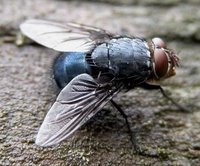I was pacing along the front of the large redbrick warehouse building when something caught my eye - A small movement across the surface of the vast wall - a rash of dark flies were sunbathing in the morning light and they moved as one when my shadow fell across them. On closer inspection, I realised that they were blowflies just emerging from behind a triangular metal sign that clung by a couple of rusty nails to the red brick. The blowfly was given the wonderfully evocative name of Calliphora vomitoria by that master taxonomer Carl Linnaeus in 1758. As the name might suggest, it has the unappealing habit of feeding on carrion. The adults have an unerring ability to find a body within hours of death, so much so that pathologists are able to estimate with some accuracy the time of death. All they need to note is the ambient temperature, and the size and number of the maggots present (for more info, click here).
These flies, however, were not actively seeking corpses but merely preparing for hibernation. They were emerging from their communal bed like festival campers emerging from beneath their flysheets, the 'morning after the night before'. Ablutions were the priori
 ty with each fly delicately brushing their feet together (fore- and hind-) and then sweeping over their big compound eyes. The temperature during the night had dropped well below freezing point, so now they relied on the sun to raise the temperature of their cold blood and make their muscles work. As I moved away from them to head home, about twenty took to the wing briefly while the remainder were still emerging, stiff-legged and sleepy.
ty with each fly delicately brushing their feet together (fore- and hind-) and then sweeping over their big compound eyes. The temperature during the night had dropped well below freezing point, so now they relied on the sun to raise the temperature of their cold blood and make their muscles work. As I moved away from them to head home, about twenty took to the wing briefly while the remainder were still emerging, stiff-legged and sleepy.
1 comment:
I love the idea of a year in the life of the old railway - your photographs and descriptions are truly evocative. I look forward to watching how things change with the seasons. Thank you for a welcome respite from the laundry...
Post a Comment